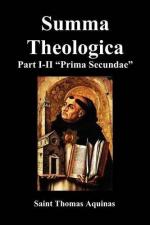We must therefore distinguish three kinds of precept in the Old Law; viz. moral precepts, which are dictated by the natural law; ceremonial precepts, which are determinations of the Divine worship; and judicial precepts, which are determinations of the justice to be maintained among men. Wherefore the Apostle (Rom. 7:12) after saying that the “Law is holy,” adds that “the commandment is just, and holy, and good”: “just,” in respect of the judicial precepts; “holy,” with regard to the ceremonial precepts (since the word “sanctus”—“holy”—is applied to that which is consecrated to God); and “good,” i.e. conducive to virtue, as to the moral precepts.
Reply Obj. 1: Both the moral and the judicial precepts aim at the ordering of human life: and consequently they are both comprised under one of the heads mentioned by Augustine, viz. under the precepts of the life we have to lead.
Reply Obj. 2: Judgment denotes execution of justice, by an application of the reason to individual cases in a determinate way. Hence the judicial precepts have something in common with the moral precepts, in that they are derived from reason; and something in common with the ceremonial precepts, in that they are determinations of general precepts. This explains why sometimes “judgments” comprise both judicial and moral precepts, as in Deut. 5:1: “Hear, O Israel, the ceremonies and judgments”; and sometimes judicial and ceremonial precepts, as in Lev. 18:4: “You shall do My judgments, and shall observe My precepts,” where “precepts” denotes moral precepts, while “judgments” refers to judicial and ceremonial precepts.
Reply Obj. 3: The act of justice, in general, belongs to the moral precepts; but its determination to some special kind of act belongs to the judicial precepts. ________________________
FIFTH ARTICLE [I-II, Q. 99, Art. 5]
Whether the Old Law Contains Any Others Besides the Moral, Judicial, and Ceremonial Precepts?
Objection 1: It would seem that the Old Law contains others besides the moral, judicial, and ceremonial precepts. Because the judicial precepts belong to the act of justice, which is between man and man; while the ceremonial precepts belong to the act of religion, whereby God is worshipped. Now besides these there are many other virtues, viz. temperance, fortitude, liberality, and several others, as stated above (Q. 60, A. 5). Therefore besides the aforesaid precepts, the Old Law should comprise others.
Obj. 2: Further, it is written (Deut. 11:1): “Love the Lord thy God, and observe His precepts and ceremonies, His judgments and commandments.” Now precepts concern moral matters, as stated above (A. 4). Therefore besides the moral, judicial and ceremonial precepts, the Law contains others which are called “commandments.” [The “commandments” (mandata) spoken of here and in the body of this article are not to be confused with the Commandments (praecepta) in the ordinary acceptance of the word.]




